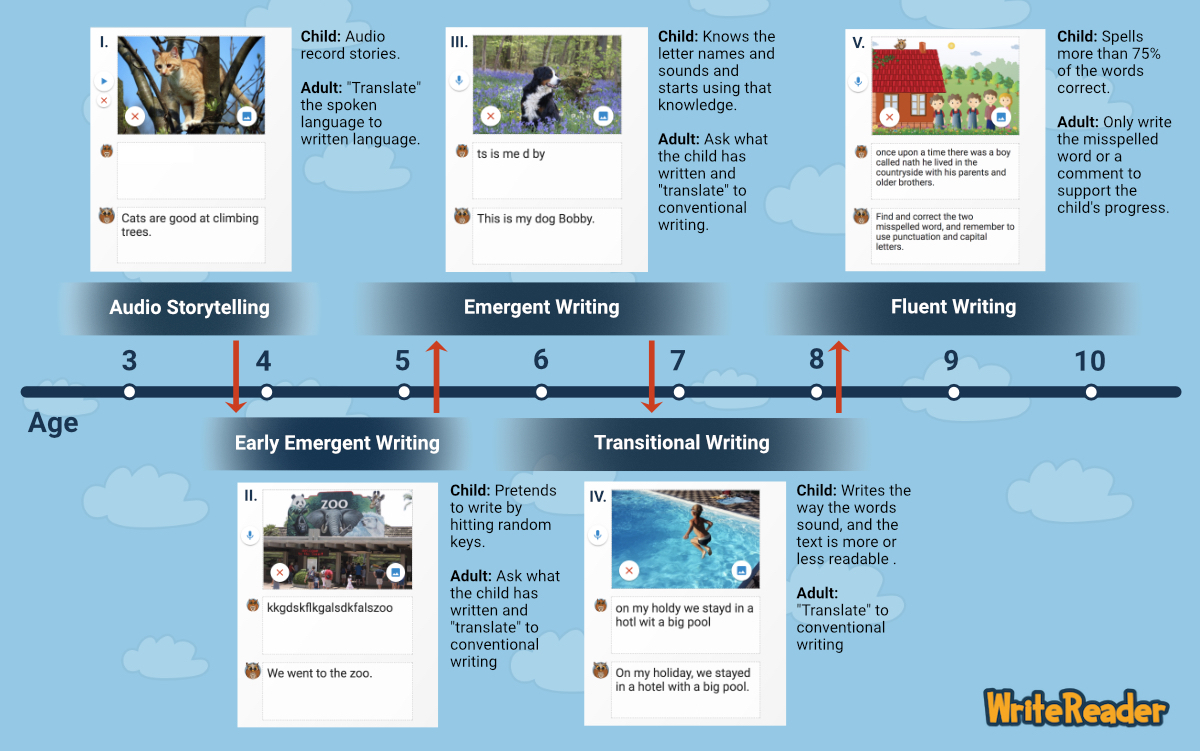When did you learn to write? It’s hard to remember, isn’t it? It’s not just because it was so long ago but also because it didn’t happen at one exact moment in time. It happened over time. Just like their bodies, children’s knowledge and skills grow in spurts and stops, as well as sudden peaks and long plateaus.

To help and support children’s writing progression as best as possible, it’s important to understand the different writing stages. Please note that the developmental stages overlap and the age references are a generalization.
Audio storytelling (3-4 years)
- This stage is based on the spoken language and gives the youngest users the opportunity to tell stories by using the recording function.
- Parents and teachers should ’translate’ children’s audio recordings into written language by adding text to the adult text field. This gives children valuable insight into the purpose of writing, and shows similarities and differences between spoken and written language.
More stage information and inspiration
Early Emergent Writing (4-5 years)
- The first writing stage is characterized by ’scribbling,’ where children pretend that they are writing by hitting random keys on the keyboard. It also includes ’logographic’ writing of high frequency and easily recognizable words like the child’s name and text logos like LEGO, McDonald’s, and Oreo.
- Turn on the key function that provides audio support for the letter names. This allows children to make the connection between the letter and its name while they ’scribble’.
- Continue to add conventional writing (’translation) in the adult writing field, which gives the child the chance to see the spelling of familiar words.
More stage information and inspiration
Emergent Writing (5-7 years)
- By now, children have gained an initial understanding of phonics, which is the correspondence between letters patterns (graphemes) and sounds (phonemes). Some of the words may have the correct initial letter and a few other letters.
- Set the audio support to letter sounds (phonemes). Continue to provide conventional writing to help the child understand the letter/sound relationship more fully.
- Children begin to make the reading-writing connection and are much more aware of embedded clues, such as picture and initial letter clues. When it comes to reading WriteReader books, be sure that they read the conventional text to recognize and learn from the correctly spelled words.
More stage information and inspiration
Transitional Writing (6-8 years)
- At this stage, there is a one-to-one relationship between the letters and sounds represented in children’s writing. For example, word like ’people’ could be spelled ’pepl’.
- Even though children’s writing has now reached a certain level where it may be able to be read by others, providing conventional writing is still very important to writing progress.
- Children will learn through comparison that many letters have different sounds and that some are silent. At the same time, children will start to notice and learn about the use of punctuation and capital letters.
More stage information and inspiration
Fluent Writing (8-10 years)
- Around this age, children start to notice and learn all the irregularities in written language. It’s the longest learning phase in writing development and can extend over several years.
- Children can turn off the key sounds at this stage, if this support is not needed.
- When children are able to spell more than 75% of the words correctly, it no longer makes sense to ’translate’ their writing in the adult text field. Instead, the teacher/parent can try these suggestions:
- Write the misspelled words in the adult text field.
- Write a comment that can guide the children to correct themselves. For example, ’Find and correct two misspelled words’ or ’Remember to use punctuation and capital letters.’
Most importantly, give your children or students plenty of praise, encouragement, and opportunities to practice writing.
Try out WriteReader for free at app.writerader.com
By Janus Madsen, 2019 (WriteReader)
